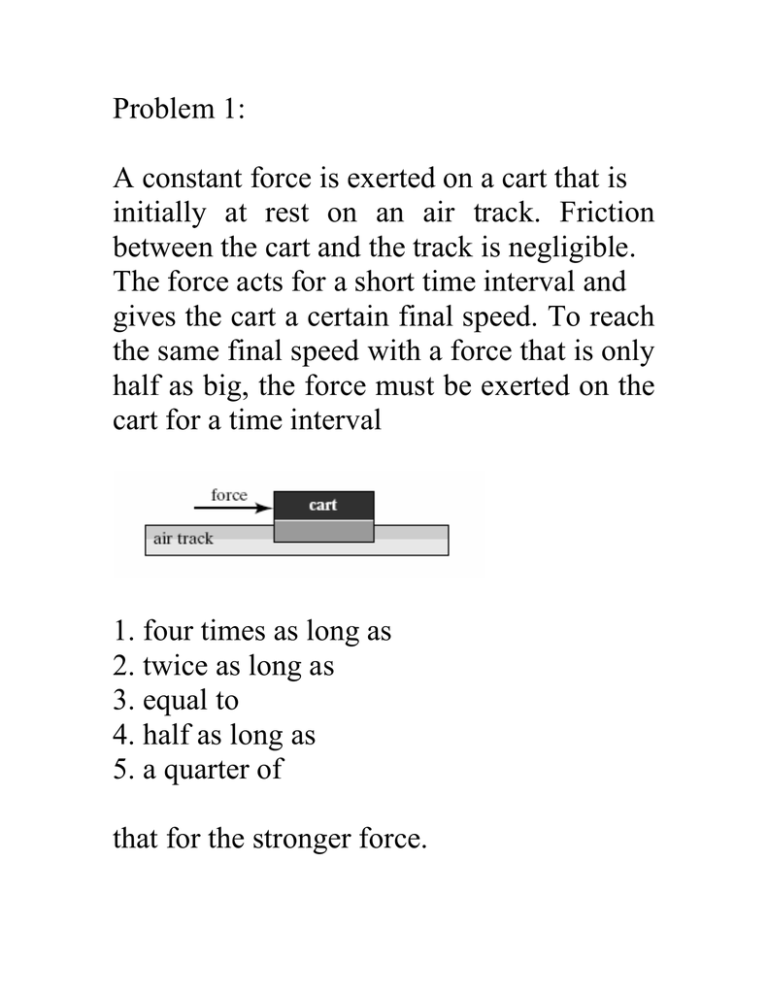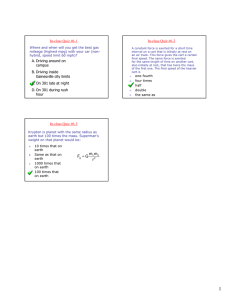Document 13605657
advertisement

Problem 1: A constant force is exerted on a cart that is initially at rest on an air track. Friction between the cart and the track is negligible. The force acts for a short time interval and gives the cart a certain final speed. To reach the same final speed with a force that is only half as big, the force must be exerted on the cart for a time interval 1. four times as long as 2. twice as long as 3. equal to 4. half as long as 5. a quarter of that for the stronger force. Problem 2: A constant force is exerted for a short time interval on a cart that is initially at rest on an air track. This force gives the cart a certain final speed. The same force is exerted for the same length of time on another cart, also initially at rest, that has twice the mass of the first one. The final speed of the heavier cart is 1. one-fourth 2. four times 3. half 4. double 5. the same as that of the lighter cart. Problem 3: You are a passenger in a car and not wearing your seat belt. Without increasing or decreasing its speed, the car makes a sharp left turn, and you find yourself colliding with the right-hand door. Which is the correct analysis of the situation? 1. Before and after the collision, there is a rightward force pushing you into the door. 2. Starting at the time of collision, the door exerts a leftward force on you. 3. both of the above. 4. neither of the above. Problem 4: Consider a car at rest. We can conclude that the downward gravitational pull of Earth on the car and the upward contact force of Earth on it are equal and opposite because 1. the two forces form an interaction pair. 2. the net force on the car is zero. 3. neither of the above. Problem 5: A person is initially standing inside a closed box that is resting on a scale. The person jumps in the air. Assume the scale can adjust instantaneously to any change in applied force. While the person is in the air inside the box, does the scale a) increase its reading from when the person is standing on the floor? , b) decrease its reading from when the person is standing on the floor? , c) give the same reading from when the person is standing on the floor? . d) Cannot decide. Problem 6: Consider a person standing in an elevator that is accelerating upward. The upward normal force N exerted by the elevator floor on the person is 1. larger than 2. identical to 3. smaller than the downward force of gravity on the person. Problem 7: You are pushing a wooden crate across the floor at constant speed. You decide to turn the crate on end, reducing by half the surface area in contact with the floor. In the new orientation, to push the same crate across the same floor with the same speed, the force that you apply must be about 1. four times as great 2. twice as great 3. equally great 4. half as great 5. one-fourth as great as the force required before you changed the crate’s orientation. Problem 8: An object is held in place by friction on an inclined surface. The angle of inclination is increased until the object starts moving. If the surface is kept at this angle, the object 1. slows down. 2. moves at uniform speed. 3. speeds up. 4. none of the above Problem 9: A massive rope pulls a block with friction between the block and the table. Is the tension in the rope 1) greater than the pulling force? 2) equal to the pulling force? 3) less than the pulling force? Problem 10: A force sensor on a cart is attached via a string to a hanging weight. The cart is initially held. When the cart is allowed to move does the tension in the string 1. increase? 2. stay the same? 3. decrease? 4. cannot determine. Need more information about friction acting on the system.




